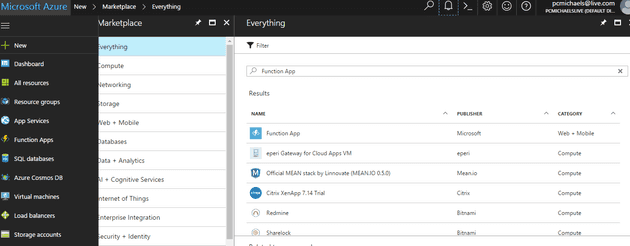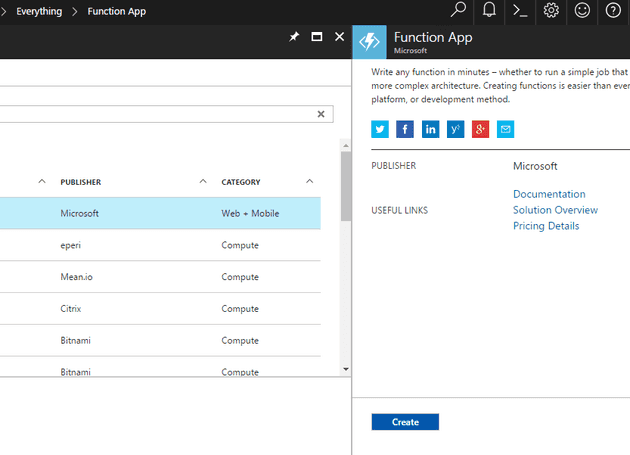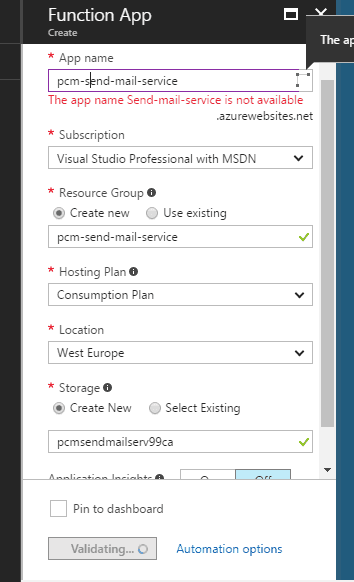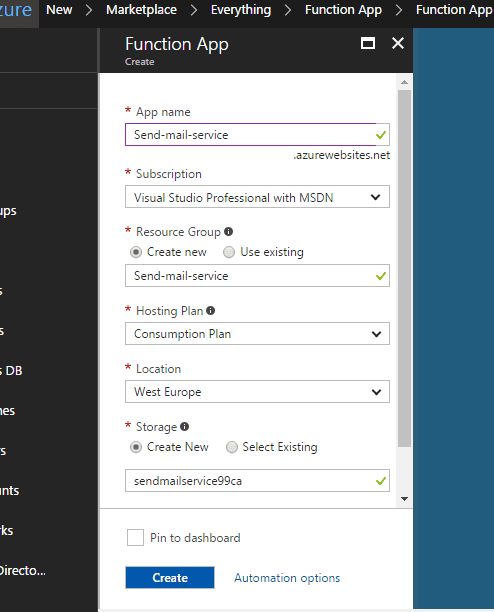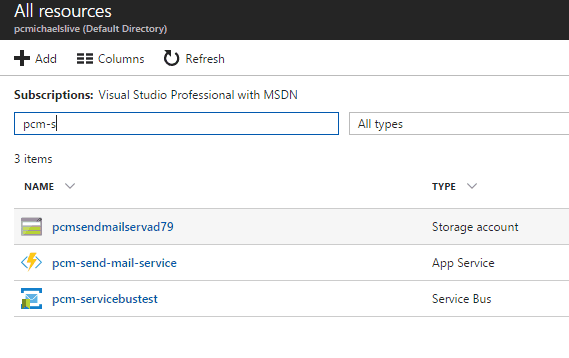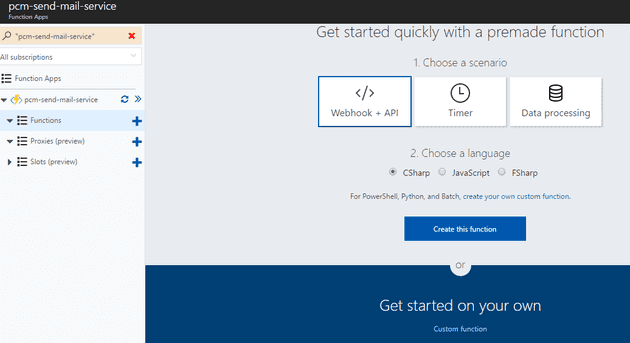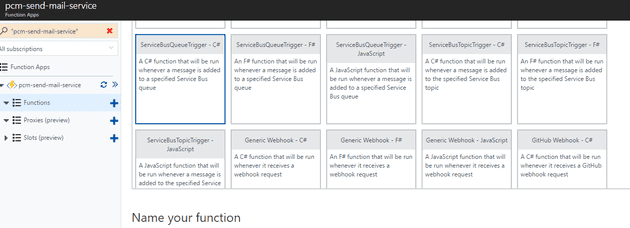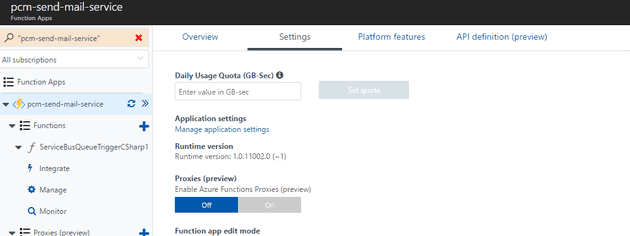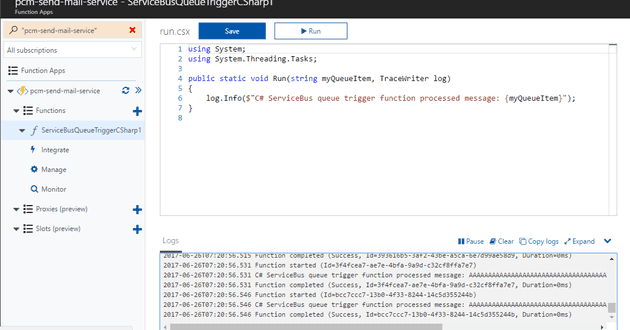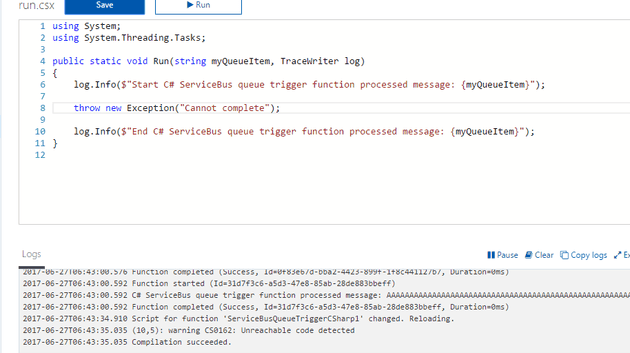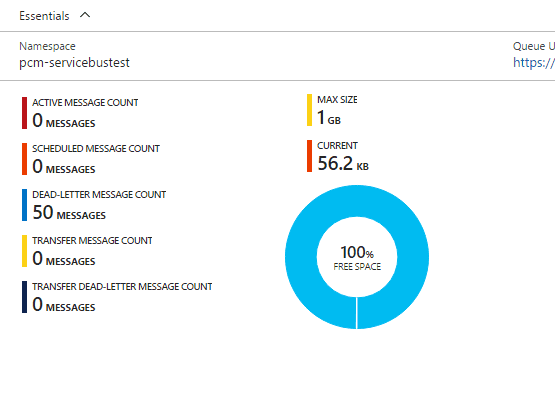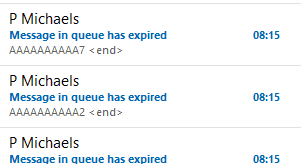In this post, I discussed creating an Azure service bus that sends an e-mail as an action once a message has expired; and in this post, I covered Azure functions and setting a basic one up.
These two pieces of functionality seem to be crying out to be together. After all, if your functionality to send an e-mail is in the cloud, you don’t have to worry about your server being down (which, if your message has expired, is a real possibility).
Create the Azure Function
The first thing to do is to create the Azure function to send an e-mail. Remember that we’ll be hooking into the service bus, and so we’ll create the function a little differently.
The first few steps are the same, though:
The new function is here:
We’ll create a custom function again:
Although this looks familiar from the last post, the next part does differ slightly. This time, we’ll set up a Service Bus Trigger:
This requires the connection string to your service bus…
As you can see above, the service bus connection is blank, and there are no possible entries… onto App Settings:
App Settings
On the App Settings tab, you can configure settings that pertain to your Azure Function App. Select “Manage App Settings”. Here we can set-up a connection string:
Now, we should be able to see that from the Function:
Does it work?
What does this function do out of the box?
Well, having populated the queue with 50 messages that time out after 30 seconds, the function kicked in and started logging that it was picking up messages after 30 seconds - so that’s a promising sign!
The messages are processed and removed from the dead letter queue. This process happens so quickly, it’s easy (as I did) to interpret this as a bug (i.e. messages are not being dead-lettered). However, as we can see from the function logs - they are.
This did, however, leave me with a concern that the messages were being disposed of before they had been successfully processed. To check this, I changed the function slightly:
So, it crashes correctly:
And here, safe and sound, are 50 freshly dead-lettered messages:
Function Code
Now we have a function, we need to make it send an e-mail… so we’ll need some code. Let’s start with what we created here.
using System;
using System.Threading.Tasks;
using System.Net.Mail;
public static void Run(string myQueueItem, TraceWriter log)
{
log.Info($"Start C# ServiceBus queue trigger function processed message: {myQueueItem}");
System.Net.Mail.MailMessage message = new System.Net.Mail.MailMessage();
message.To.Add("[email protected]");
message.Subject = "Message in queue has expired";
message.From = new System.Net.Mail.MailAddress("[email protected]");
message.Body = messageText;
System.Net.Mail.SmtpClient smtp = new System.Net.Mail.SmtpClient("smtp.live.com");
smtp.Port = 587;
smtp.UseDefaultCredentials = false;
smtp.Credentials = new System.Net.NetworkCredential("[email protected]", "p@ssw0rd");
smtp.EnableSsl = true;
smtp.Send(message);
log.Info($"End C# ServiceBus queue trigger function processed message: {myQueueItem}");
}
This doesn’t work:
2017-06-27T16:47:56.928 Function started (Id=1188dbdb-4963-4e55-af5c-4be1f71a1ca5) 2017-06-27T16:47:56.928 Start C# ServiceBus queue trigger function processed message: AAAAAAAAAAAAAAAAAAAAAAAAAAAAAAAAAAAAAAAAAAAAAAAAAAAAAAAAAAAAAAAAAAAAAAAAAAAAAAAAAAAAAAAAAAAAAAAAAAAAAAAAAAAAAAAAAAAAAAAAAAAAAAAAAAAAAAAAAAAAAAAAAAAAAAAAAAAAAAAAAAAAAAAAAAAAAAAAAAAAAAAAAAAAAAAAAAAAAAAAAAAAAAAAAAAAAAAAAAAAAAAAAAAAAAAAAAAAAAAAAAAAAAAAAAAAAAAAAAAAAAAAAAAAAAAAAAAAAAAAAAAAAAAAAAAAAAAAAAAAAAAAAAAAAAAAAAAAAAAAAAAAAAAAAAAAAAAAAAAAAAAAAAAAAAAAAAAAAAAAAAAAAAAAAAAAAAAAAAAAAAAAAAAAAAAAAAAAAAAAAAAAAAAAAAAAAAAAAAAAAAAAAAAAAAAAAAAAAAAAAAAAAAAAAAAAAAAAAAAAAAAAAAAAAAAAAAAAAAAAAAAAAAAAAAAAAAAAAAAAAAAAAAAAAAAAAAAAAAAAAAAAAAAAAAAAAAAAAAAAAAAAAAAAAAAAAAAAAAAAAAAAAAAAAAAAAAAAAAAAAAAAAAAAAAAAAAAAAAAAAAAAAAAAAAAAAAAAAAAAAAAAAAAAAAAAAAAAAAAAAAAAAAAAAAAAAAAAAAAAAAAAAAAAAAAAAAAAAAAAAAAAAAAAAAAAAAAAAAAAAAAAAAAAAAAAAAAAAAAAAAAAAAAAAAAAAAAAAAAAAAAAAAAAAAAAAAAAAAAAAAAAAAAAAAAAAAAAAAAAAAAAAAAAAAAAAAAAAAAAAAAAAAAAAAAAAAAAAAAAAAAAAAAAAAAAAAAAAAAAAAAAAAAAAAAAAAAAAAAAAAAAAAAAAAAAAAAAAAAAAAAAAAAAAAAAAAAAAAAAAAAAAAAAAAAAAAAAAAAAAAAAAAAAAAAAAAAAAAAAAAAAAAAAAAAAAAAAAAAAAAAAAAAAAAAAAAAAAAAAAAAAAAAAAAAAAAAAAAAA32 2017-06-27T16:47:56.928 Function completed (Failure, Id=1188dbdb-4963-4e55-af5c-4be1f71a1ca5, Duration=0ms) 2017-06-27T16:47:57.147 Exception while executing function: Functions.ServiceBusQueueTriggerCSharp1. mscorlib: Exception has been thrown by the target of an invocation. f-ServiceBusQueueTriggerCSharp1__-1971403142: Cannot complete. 2017-06-27T16:47:57.557 Exception while executing function: Functions.ServiceBusQueueTriggerCSharp1. mscorlib: Exception has been thrown by the target of an invocation. f-ServiceBusQueueTriggerCSharp1__-1971403142: Cannot complete.
Debugging Azure
A quick side note on debugging Azure. There are a number of resources with details of how this should work on the web, and I’ll probably have a later post of my own experiences, but it’s a pretty flaky experience, and I ended up using trial and error to determine the issue.
Working code
using System;
using System.Threading.Tasks;
public static void Run(string myQueueItem, TraceWriter log)
{
log.Info($"Start C# ServiceBus queue trigger function processed message: {myQueueItem}");
System.Net.Mail.MailMessage message = new System.Net.Mail.MailMessage();
message.To.Add("[email protected]");
message.Subject = "Message in queue has expired";
message.From = new System.Net.Mail.MailAddress("[email protected]");
message.Body = myQueueItem;
System.Net.Mail.SmtpClient smtp = new System.Net.Mail.SmtpClient("smtp.live.com");
smtp.Port = 587;
smtp.UseDefaultCredentials = false;
smtp.Credentials = new System.Net.NetworkCredential("[email protected]", "p@ssw0rd");
smtp.EnableSsl = true;
smtp.Send(message);
log.Info($"End C# ServiceBus queue trigger function processed message: {myQueueItem}");
}
So, the problem was just that I was referencing an unknown variable (messageText). I’m unsure exactly why I needed to travel to the mountains of Mordor to determine this - a simple error message in the online text would have sufficed.
The other issue that I faced was a security challenge; however, once I’d persuaded Azure that this really was me, everything sprung into life:
Credit Considerations
Unlike in previous posts where I’ve identified the Azure cost to be negligible, functions are the fastest way to use up credit I have found so far. Especially functions such as I’ve created here. I left the (non-working) function above active, but failing all night, and it used up over £40 worth of credit, continually trying, and failing, to process the dead-letter queue… I think the lights might even have dimmed in Redmond for a split second! The moral of the story is is: be careful when you’re debugging this - you can’t just leave at the end of the night with a function that doesn’t work, but is still active.
Summary
This concept is extremely compelling. I can have a service bus queue that is processed and monitored by an Azure function. If aliens land and steal the entire office, all the servers, dev PCs and programmers, this function will continue to run. There is obviously a mindset shift here, and it doesn’t make sense to move everything into this kind of model, but consider the possibilities; imagine a system that books holidays: it processes the customer request and adds it to a queue; the aeroplane booking system picks that from the queue and books the ticket on the plane, the car hire system takes the message to book a car, once they’re all complete they add respective messages to say so (but remain agnostic of each other), finally, if any one part of the system fails, an Azure function could sit there monitoring and cancel the whole lot. I’ve never worked in this kind of industry, so there’s a lot that I’ve probably not considered, but the essence is that you can have active functionality on (even catastrophic) failure - which is a brand new concept.
References
https://docs.microsoft.com/en-us/azure/azure-functions/functions-bindings-service-bus
https://stackoverflow.com/questions/10043219/view-content-of-an-azure-service-bus-queue
Service Bus Explorer:
https://code.msdn.microsoft.com/Service-Bus-Explorer-f2abca5a
http://markheath.net/post/remote-debugging-azure-functions
